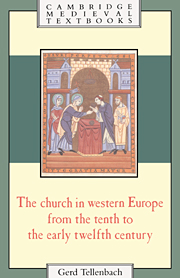Book contents
- Frontmatter
- Contents
- Translator's note
- Author's preface
- List of abbreviations
- 1 Western Christendom and its environment in the tenth and eleventh centuries
- 2 The church and its manifestations on earth
- 3 The material existence of the churches and the clergy
- 4 Religious life and thought
- 5 The beginnings of the revolution in church history
- 6 Gregory VII (1073–1085)
- 7 Continuing conflicts between established principles
- 8 Pope, church, and Christendom
- Epilogue
- Select bibliography
- Index
- Cambridge Medieval Textbooks
3 - The material existence of the churches and the clergy
Published online by Cambridge University Press: 05 June 2012
- Frontmatter
- Contents
- Translator's note
- Author's preface
- List of abbreviations
- 1 Western Christendom and its environment in the tenth and eleventh centuries
- 2 The church and its manifestations on earth
- 3 The material existence of the churches and the clergy
- 4 Religious life and thought
- 5 The beginnings of the revolution in church history
- 6 Gregory VII (1073–1085)
- 7 Continuing conflicts between established principles
- 8 Pope, church, and Christendom
- Epilogue
- Select bibliography
- Index
- Cambridge Medieval Textbooks
Summary
Even in the time of the early church, when Christians still anticipated the Lord's return in the immediate future, the question of how the communities' material needs were to be met presented itself nevertheless. It became ever more pressing as the numbers of the faithful grew and the Lord's return was delayed. There was a need for rooms to meet in and for money, either to acquire liturgical utensils, lights, and the food for common meals, or to support brothers and sisters in need, or to lay out and decorate cemeteries and church buildings. To send information to befriended communities or to travel to them also cost money. When the bishops and their helpers ceased to be able to support themselves from the fruits of their labours, the communities had to provide for them.
From the beginning it was laid down that all the faithful should, if possible, bring their offerings to the altar during divine service. These were then to be accepted and divided out. But quite apart from such consumable income the communities could through gifts and testaments also become owners of money, houses, and property, and hence could dispose not only of income which had to be spent immediately but also of more permanent forms of wealth.
Wealth always has a secular character; even when it is owned and used by churches it is subject to the legal and economic constraints of its time.
- Type
- Chapter
- Information
- Publisher: Cambridge University PressPrint publication year: 1993



